It is quite common to find caterpillars in forests, gardens, and woodlands in Pennsylvania. These quirky creatures are known for transforming into beautiful butterflies or moths. One can often find them hiding under leaves, among nettles, in hedges, and in the grass. Below is an article about 13 caterpillars found in Pennsylvania, six of which are poisonous.

1. Monarch Caterpillar
It’s hard not to recognize the Monarch caterpillar with its plump body and white, black, and yellow stripes. Each end of their bodies has a pair of black tentacles, and their legs and pro-legs are very pronounced. Their favorite host plant is the milkweed. Like the butterflies, this caterpillar is the most recognized insect in Pennsylvania. They look almost cartoonish with their distinctive tentacles and stripes. However, their coloring serves a purpose, which is to scare away predators.

It’s hard not to recognize the Monarch caterpillar with its plump body and black, white, and yellow bands. Each end of their bodies has spindly black tentacles, and their legs and pro-legs are very pronounced.
©iStock.com/CathyKeifer
2. Woolly Bear
The woolly bear is a caterpillar found in Pennsylvania. They are black with a thick rusty-red band in the center. These caterpillars are covered in coarse, dense hairs, which is one of their most identifiable features. Woolly bears eventually transform into Isabella tiger moths. They are opportunistic feeders, meaning they eat basically any plant. But the most interesting thing about these caterpillars is the way they hibernate. Well, they don’t necessarily hibernate. Instead of pupating or burrowing to get away from the cold, they freeze themselves. Woolly bears have a chemical in their blood that helps them thaw, and they continue living life during the spring as if nothing has happened.
These caterpillars can survive in extremely varied climates. In fact, they are one of the few species that can live in the Arctic. This is due to their diet, as they eat almost anything, including grasses, herbs, and tree leaves. As a result, they occur where plants grow. You can find them in clusters near the base of the plant.
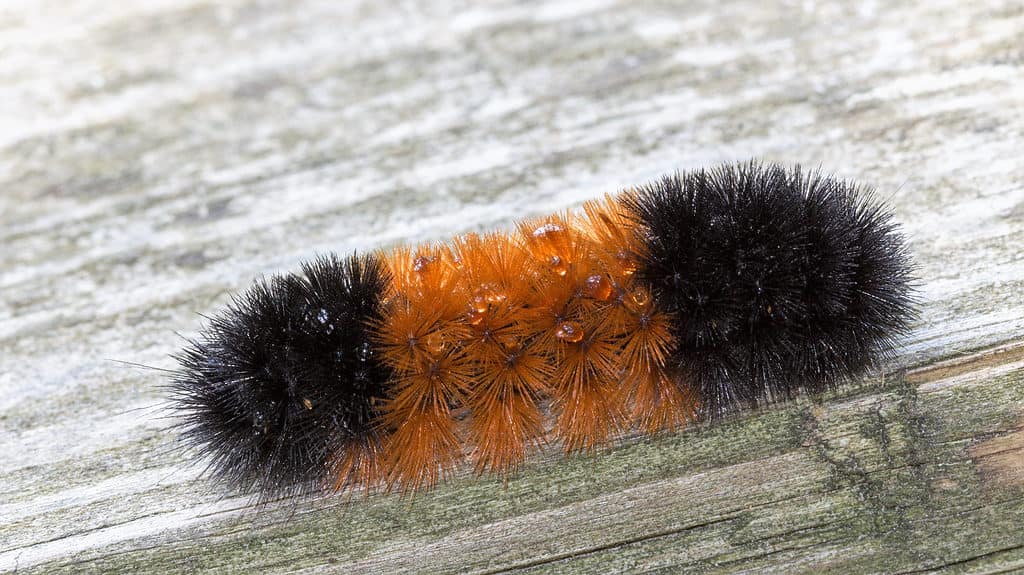
Woolly bears eventually transform into Isabella tiger moths. They are opportunistic feeders, meaning they eat basically any plant.
©Kimberly Boyles/Shutterstock.com
3. Large Maple Spanworm
Large maple spanworms have gray-brown coloring, with tiny black spots covering their bodies. In addition, these caterpillars often have a bark-like pattern. They feed on a variety of plants and trees, like maple, birch, apple, cherry, poplar, oak, willow, walnut, soybean, geranium, currant plants, blueberry, and grass.
Large maple snapworms are very lucky because they have one of the best camouflages of any caterpillars found in Pennsylvania. For example, they look like a twig or piece of bark, no matter your proximity. As a result, they can easily hide from predators, giving them the upper hand.
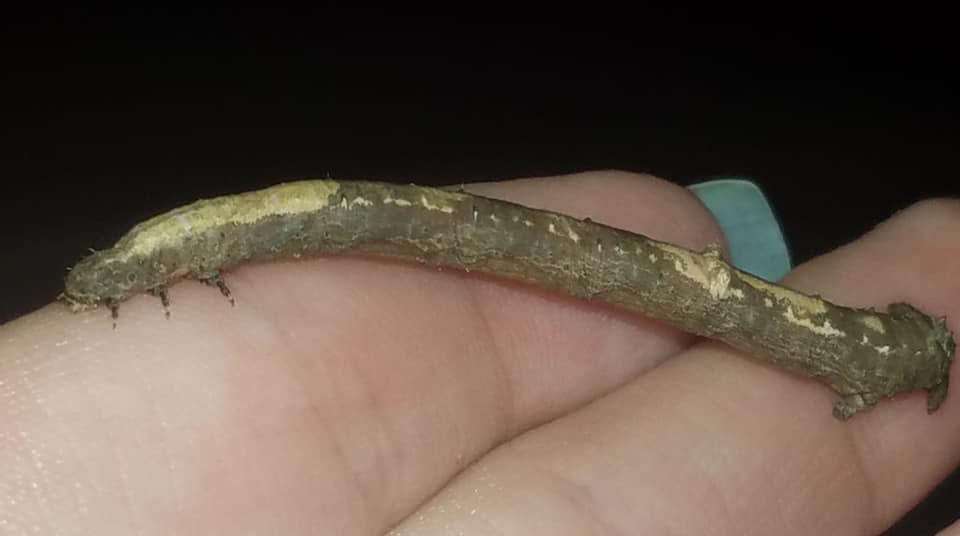
Maple spanworms have gray-brown coloring, with tiny black spots covering their bodies. In addition, these caterpillars often have a bark-like pattern.
©Andy Reago & Chrissy McClarren / CC BY 2.0 – License
4. Variegated Fritillary Caterpillar
The Variegated Fritillary caterpillar has red, black, and white stripes running the length of its body. Furthermore, they have black branched spines protruding out from every segment in rows. These caterpillars will use any plant in the alder or violet family as a host. This includes pansies, yellow alder, and violets. They also share the same name as their adult counterparts, the Variegated Fritillary butterfly. These caterpillars feed on ornamental plants, like passionflower, violets, and pansies.

The Variegated Fritillary caterpillar has red, black, and white stripes running the length of its body. Furthermore, they have black branched spines protruding out from every segment in rows.
©Brett Hondow/Shutterstock.com
5. Spiny Oak Slug Caterpillar (Poisonous)
Spiny oak slug caterpillars are one of Pennsylvania’s poisonous caterpillars. Their toxicity causes an itchy or burning sensation and inflammation at the point of contact. They transform into the spiny oak slug moth. Larvae measure around .05 inches, reaching approximately .75 inches long when fully grown. You can find these caterpillars on a wide range of deciduous trees and shrubs, which make up most of their diets.
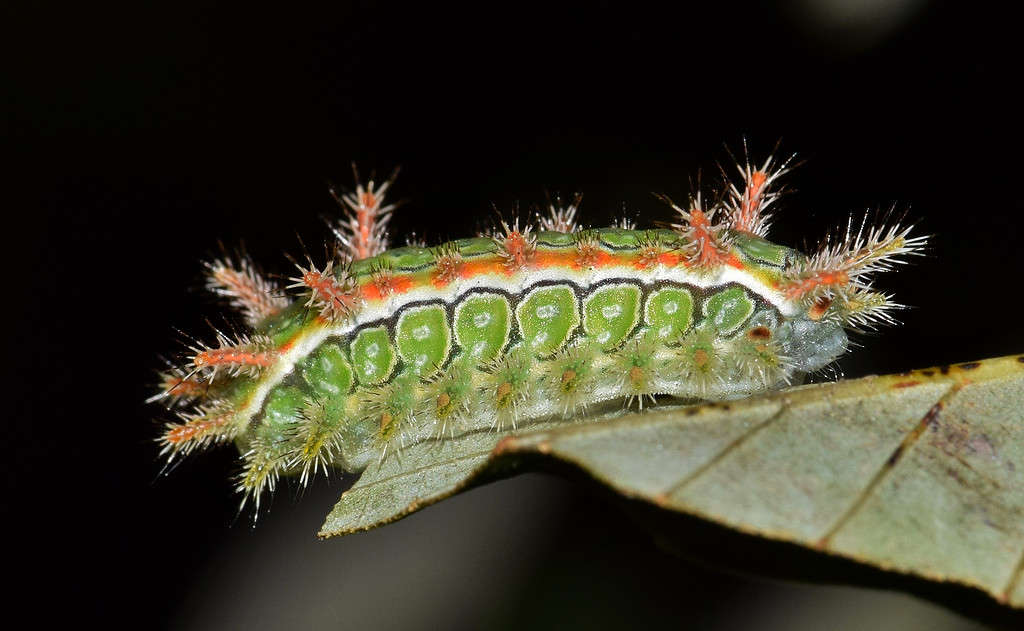
Spiny oak slug caterpillars are one of Pennsylvania’s poisonous caterpillars. Their toxicity causes an itchy or burning sensation and inflammation at the point of contact.
©Brett_Hondow/iStock via Getty Images
6. Buck Moth Caterpillar (Poisonous)
Buck Moth Caterpillars are poisonous. They can cause an immediate burning sensation at the point of contact, followed by inflammation or blistering at the contact point. These symptoms can last for around five hours. However, the red mark around the contact site will take longer to fade. Unfortunately, some people experience more severe conditions, including asthma-like issues, migraines, shock, gastrointestinal disorders, and hemorrhaging. Once transformed, they are known as the buck moth. Buck moth caterpillar larvae are around .15 inches long but can reach as much as 2.5 inches once fully grown. They commonly feed on vegetation like scrub oak, and these caterpillars primarily inhabit deciduous woodlands.

Buck Moth Caterpillars are poisonous. They can cause an immediate burning sensation at the point of contact, followed by inflammation or blistering at the contact point.
©iStock.com/Oleg Marchak
7. White Hickory Tussock Caterpillar (Poisonous)
The white hickory Tussock caterpillar is one of Pennsylvania’s poisonous caterpillars. When they make contact with human skin, it causes a rash, burning, pain, and swelling. More extreme cases also experience nausea. Once they have transformed, they are called the white hickory Tussock moth. Their larvae are tiny, barely measuring 0.05 inches long, but they can grow up to 2 inches long when fully grown. White hickory Tussock caterpillars feed on plants and trees, like walnut and hickory, oak, apple, willow, garden plants, and shrubs. They are primarily found in Pennsylavania’s suburban areas or deciduous woodlands.
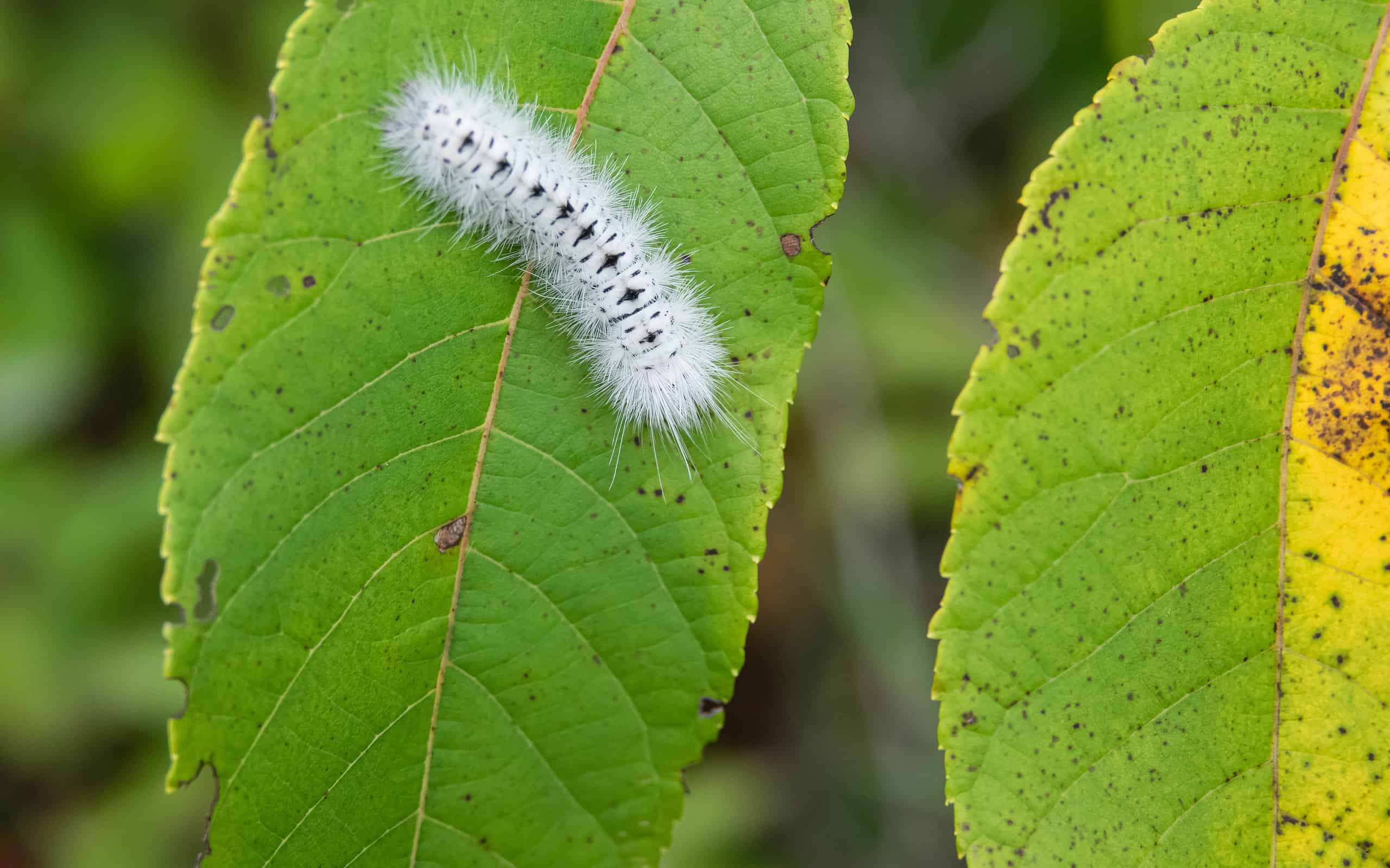
The white hickory Tussock caterpillar is one of Pennsylvania’s poisonous caterpillars. When they make contact with human skin, it causes a rash, burning, pain, and swelling.
©ErikAgar/iStock via Getty Images
8. Puss Caterpillar (Poisonous)
The puss caterpillar, found in Pennsylvania, is one of the most poisonous caterpillars in the United States. However, some people have worse reactions than others. If you make contact with one of these caterpillars, you will immediately feel an intense burning, followed by redness and swelling at the point of contact. Other symptoms include rapid heart rate, headache, nausea, fever, low blood pressure, abdominal pain, seizures, convulsions, and muscle spasms.
Puss caterpillars transform into hag moths. Their larvae are tiny, only measuring 0.05 inches, but when fully grown, they can reach 1.6 inches long. These caterpillars feed off plants and trees, including ash, apple, dogwood, birch, hickory, elm, oaks, and other woody plants.

The puss caterpillar, found in Pennsylvania, is one of the most poisonous caterpillars in the United States. However, some people have worse reactions than others.
©Lukas Jonaitis/Shutterstock.com
9. Monkey Slug (Poisonous)
The monkey slug is also poisonous; touching one causes itching and pain at the contact site. This is followed by a welt surrounded by inflammation. When they are larvae, they only measure .15 inches in length, but they grow to around 2.5 inches long before they transform into moths. Monkey slugs eat vegetation like plants and trees, including blackberry, alder, cherry, hickory, hackberry, pear, maple, and wisteria. These caterpillars are primarily found in deciduous woodlands and suburban areas.

The monkey slug is also poisonous; touching one causes itching and pain at the contact site. This is followed by a welt surrounded by inflammation.
©ePhotocorp/iStock via Getty Images
10. Saddleback Caterpillar (Poisonous)
Saddleback caterpillars are found in Pennsylvania, and they are poisonous. Contact with these creatures causes intense burning at the site of contact, redness, and blistering that can last for hours, leaving behind a red mark. However, more severe symptoms include shock, migraines, asthma-like issues, gastrointestinal disorders, and hemorrhaging. Once they transform, they are known as the slug moth. Their diets consist of vegetation like apple, blueberry, oak, cabbage, and grass. Saddleback caterpillars are commonly found in fields, woodlands, gardens, and the edges of wetlands.
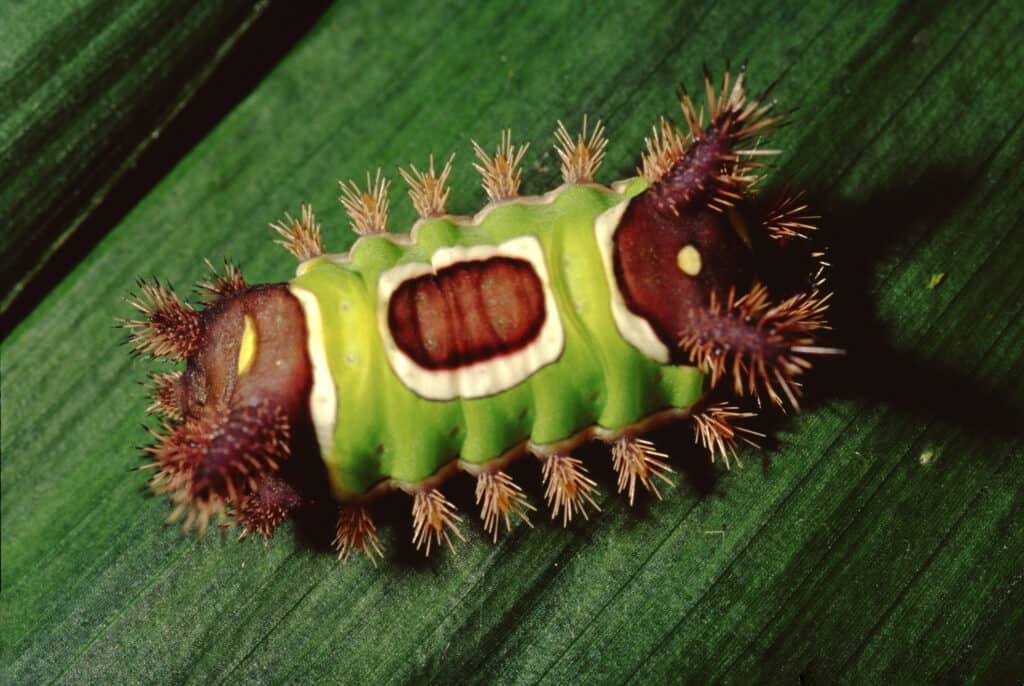
Saddleback caterpillars are found in Pennsylvania, and they are poisonous. Contact with these creatures causes intense burning at the site of contact, redness, and blistering that can last for hours, leaving behind a red mark.
©Liz Weber/Shutterstock.com
Summary of 10 Caterpillars Found in Pennsylvania
| Caterpillar | Poisonous? | |
|---|---|---|
| 1 | Monarch Caterpillar | No |
| 2 | Wooly Bear Caterpillar | No |
| 3 | Large Maple Spanworm | No |
| 4 | Variegated Fritillary Caterpillar | No |
| 5 | Spiny Oak Slug Caterpillar | Yes |
| 6 | Buck Moth Caterpillar | Yes |
| 7 | White Hickory Tussock Caterpillar | Yes |
| 8 | Puss Caterpillar | Yes |
| 9 | Monkey Slug | Yes |
| 10 | Saddleback Caterpillar | Yes |
The photo featured at the top of this post is © Gerry Bishop/Shutterstock.com
Thank you for reading! Have some feedback for us? Contact the AZ Animals editorial team.






